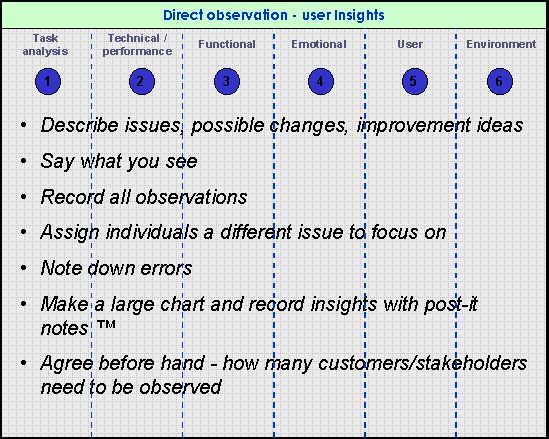Direct observation
In principle, direct observation is an incredibly simple way of gathering data about how users interact with products. However, without planning or structure, it can be difficult to digest and process insights gained. Without care, observation may also affect what people do and the type and number of people observed can bias results. Given these potential difficulties, observation is one of the most powerful tools for gaining user insight. Observation can be applied to: proposed new products - testing product concepts and models, existing products - to help guide improvement for the next generation, competitors products - to determine preference, strengths and weaknesses. As with all user understanding methods, it is important to establish how many users will provide a representative sample - this may be a smaller sample than some other methods due to the richness of information gained and the amount of time it can take.
Structure for recording observations
A useful structure is to have a small team involved in an observation exercise, where each member systematically records insights relating to a specific area of focus (see figure below):
Task analysis
Describe the sequence and timing of actions and events. Can tasks be eliminated?
Technical / performance issues
Record issues related to technical performance. Was it satisfactory, could it be improved?
Functional issues
Issues relating to product functionality and features. Were the right features present?
Emotional issues
How did the user feel? What expressions or comments were made?
User issues
Did the user require specific skills? Record comfort, ergonomics, physical and ease of use issues.
Environment issues
Did the location affect use? Were there access, noise, heat or other location issues?

Notes
- Observation can be time consuming and hence costly
- Needs careful planning in order to gain maximum benefit
- Users observed should be representative of user population and the person being observed must be comfortable with the process
- Best with full team involvement, but this can add to the cost
- Can be combined with video for data capture
- Good when combined with traditional interviews
For more information, please contact:
T: +44 1223 764830









